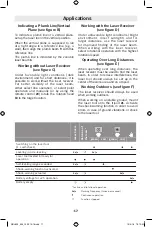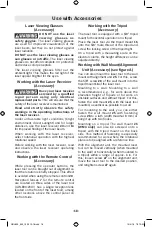
-22-
LR30 General Safety Rules
R e a d a l l
instructions.
Failure to follow all instructions
listed below may result in
hazardous radiation exposure, electric
shock, fire and/or serious injury.
Keep the laser receiver away
from cardiac pacemakers. The
magnet plate 5a generates a
field that can impair the
f u n c t i o n o f c a r d i a c
pacemakers.
• Keep the laser receiver away
from magnetic data medium and
magnetically sensitive equipment. The
effect of the magnet plate 5a can lead to
irreversible data loss.
• Have the
laser receiver
repaired only
through qualified specialists using
original spare parts. This ensures
that the safety of the
laser receiver
is
maintained.
• Do not operate the laser receiver in
explosive environments, such as in the
presence of flammable liquids, gases
or dusts. Sparks can be created in the
laser receiver which may ignite the dust
or fumes.
• Read and strictly observe the safety
warnings in the operating instructions
of the rotational laser.
Noise Information
The A-weighted sound pressure level of the
audio signal at one meter distance is 80
dB(A).
LR30 Intended Use
The laser receiver is intended for swift finding of rotating laser beams in the wavelength listed
in the “Technical Data”.
The laser receiver is suitable for indoor and outdoor use.
LR30 Preparation
Inserting/Replacing the Battery
Alkaline batteries are recommended for the
laser receiver.
Pull the latch 11a of battery lid outward and
open the battery lid 13a.
When inserting batteries, pay attention to the
correct polarity.
In the case of a dead battery, the laser re-
ceiver will beep and flash the LEDs then au-
tomatically shut down when battery has been
exhausted.
Remove the batteries
from the laser receiver
when not using it for extended periods.
When storing for extended periods, the bat-
teries can corrode and self-discharge.
GRL800_900_1000 10-18.indd 22
10/4/18 7:07 AM















































